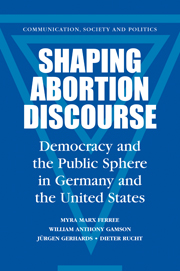Part III - Representing Different Constituencies
Published online by Cambridge University Press: 15 December 2009
Summary
This part explores the representation of the discursive interests of three major constituencies on the abortion issue. We examine who makes claims on behalf of each constituency – and their relative success in shaping abortion discourse. In Chapter Seven, we look at who attempts to represent women's claims. In both countries, there is an active women's movement that seeks to connect abortion rights to women's rights, but the movements differ in significant ways and have differential success. We examine both the voice that women have as speakers in the media discourse and the career of gendered frames sponsored by different mediators. We find that abortion is a more gender-polarized and gender-identified issue in Germany than in the United States, and has been from the very beginning of the period that we study.
Chapter Eight examines the nature of the religious constituency and the relative success of those promoting religious frames in shaping the abortion discourse. We particularly focus on the churches, active in both countries, and on the successful mobilization of the Christian Right constituency in the United States. U.S. speakers invoke religious pluralism and the diversity of moral values to legitimate choice, while German speakers assume a moral consensus from which they are more or less willing to countenance exceptions. There is also less ambivalence in Germany about the state as the guardian of morality and as a moral actor.
Chapter Nine considers the tradition of the left, a constituency that emphasizes inequality based on class, race, or ethnicity as well as gender and responds in terms of meeting needs and supporting autonomy for disadvantaged groups as well as making claims for social justice.
Information
- Type
- Chapter
- Information
- Shaping Abortion DiscourseDemocracy and the Public Sphere in Germany and the United States, pp. 129 - 130Publisher: Cambridge University PressPrint publication year: 2002
